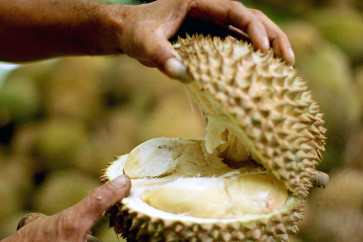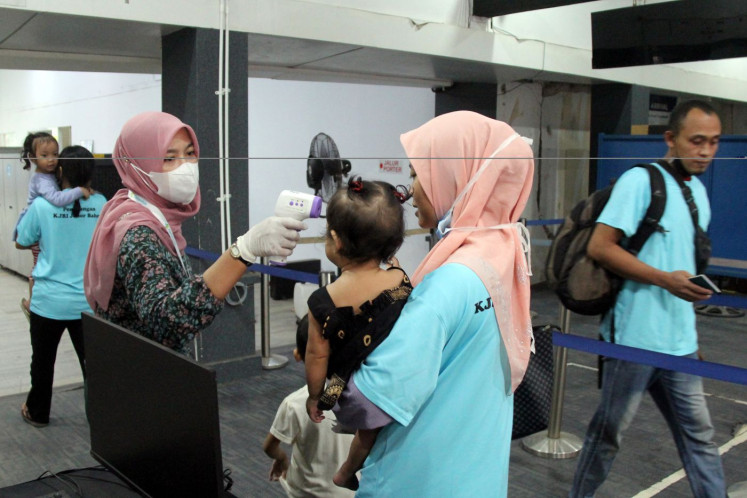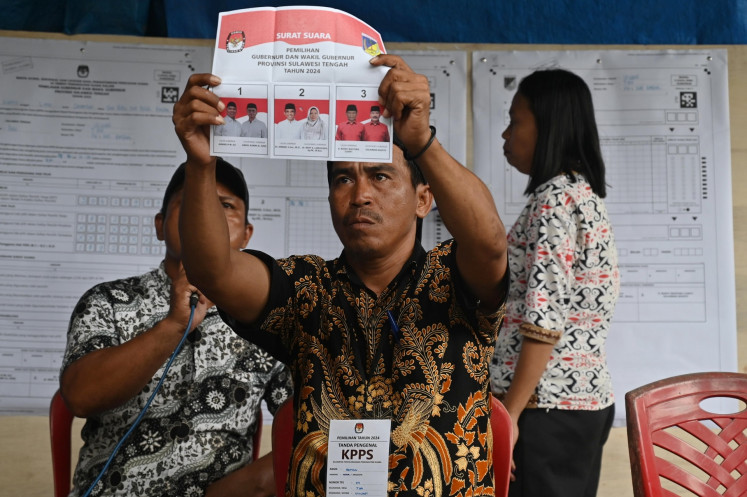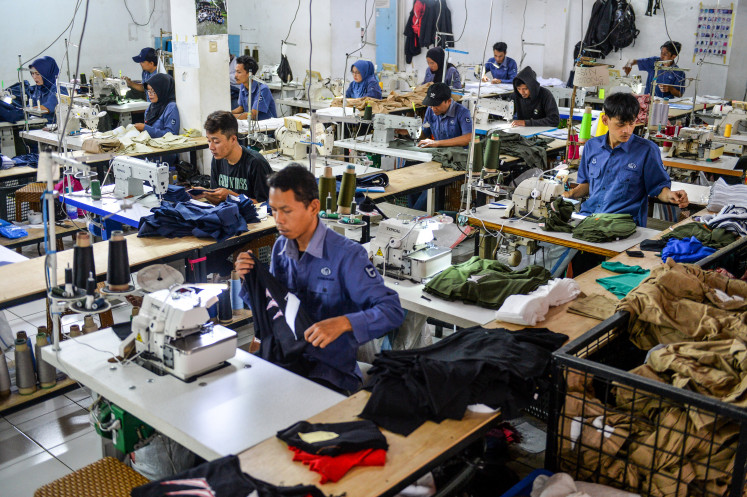Popular Reads
Top Results
Can't find what you're looking for?
View all search resultsPopular Reads
Top Results
Can't find what you're looking for?
View all search resultsLet indigenous peoples lead just energy transition
Research finds that indigenous peoples, including women and youth, can lead and have an active role as promoters of clean and sustainable energy production.
Change text size
Gift Premium Articles
to Anyone
 A member of an indigenous community holds a poster that reads “We need regulations that protect our rights from state and corporate crimes“ during a protest in front of the Senayan legislative complex in Jakarta on Oct. 11, 2024. The protesters demanded lawmakers push for protection of indigenous communities' rights and acknowledgement of their areas, as well as resolution of agrarian conflicts. (Antara/Dhemas Reviyanto)
A member of an indigenous community holds a poster that reads “We need regulations that protect our rights from state and corporate crimes“ during a protest in front of the Senayan legislative complex in Jakarta on Oct. 11, 2024. The protesters demanded lawmakers push for protection of indigenous communities' rights and acknowledgement of their areas, as well as resolution of agrarian conflicts. (Antara/Dhemas Reviyanto)
A just and fair transition to a real net-zero future without any more carbon emissions should be at the center of policymaking in Southeast Asia.
While the governments of the region profess that they have been making considerable efforts toward a future with less emissions, there is still a very long way ahead. Yet, it is fair to ask if there is a real commitment toward ensuring the sustainability of our planet, especially in a region that is among the richest in biodiversity.
But if Southeast Asia seeks to emerge as a trailblazer in a just and fair energy transition that is also equitable and prioritizes people’s rights, it has to take into account the rights of indigenous peoples, among other marginalized groups, of the region.
In doing so, it is vital to ensure that indigenous peoples are not only going to be part of the conversation about what it means, in practice, to achieve and implement a just and fair transition. They have to be at the center of this complex shift necessary to tackle the climate crisis and its impacts.
Instead, the opposite is happening. Over half of “transition minerals” are on indigenous lands, and a large percentage of renewable energy potential is located on marginalized rural communities’ lands, especially those of indigenous peoples.
A 2022 research published in Nature analyzed over 5,000 transition mineral projects, finding that 54 percent were located on or near the lands of indigenous peoples. Similarly, another study found 80 percent of the 700 mining projects for transition minerals were located near or on the territories of indigenous peoples.
When transition minerals such as bauxite and nickel are being mined or a hydropower dam and transmission lines are being constructed in Southeast Asia or in the wider Asia Pacific or elsewhere, in many instances with financing from bilateral and multilateral banks, it is a common occurrence that indigenous peoples’ rights are violated.
A reaction to these transgressions is evolving. In many places around the world, including Southeast Asia, there is an ongoing effort to advance the roles of indigenous peoples in leading such energy transition.
In September last year, the Right Energy Partnership with Indigenous People (REP), worked with the Asia Indigenous Peoples Network on Extractive Industries and Energy (AIPNEE) and the Asian Indigenous Women’s Network (AIWN), in organizing a regional conference in Bangkok.
Attended by 30 indigenous women and youth representatives from nine countries across Asia, the conference produced an important declaration that demands respect for the rights of indigenous women and youth in the just and fair energy transition.
It is a righteous and passionate call for governments, private businesses and investors to genuinely embrace partnership with women and youth from indigenous communities, the ancestral guardians of the rich biodiversity of the region.
It is essential, to always start with asking for the agreement of indigenous peoples, and that too especially of the women and youth, in line with their right to free, prior and informed consent (FPIC) of indigenous people, when energy transition projects are planned in their territories for energy transition.
The FPIC is the core element of the United Nations Declaration on the Rights of Indigenous Peoples (UNDRIP), the global legal yardstick in matter of the rights of indigenous peoples.
As the conference declaration states, the FPIC requires “ensuring that the rights of indigenous peoples, including their right to withhold or withdraw consent, for decision-making on energy transition projects”.
But the conference declaration is not only about indigenous peoples’ rights in the context of energy transition projects. Its vision is much bolder because it envisions a different model of renewable, clean energy production that is led by indigenous peoples.
It calls for the national, regional and local governments, together with the international community, to support indigenous-led solutions through “investments in community-owned, Indigenous-led renewable energy initiatives that respect self-determined development”.
The REP recently launched a major report that highlights how it is possible to advance indigenous-led energy systems in the just and green transition.
Even if implemented at small scale at the very grassroots level, the projects documented in the report prove that indigenous peoples, including women and youth, can lead and have an active role as promoters of clean and sustainable energy production.
“Indigenous peoples-led renewable energy initiatives have been implemented by indigenous peoples in Malaysia, Philippines, Cambodia, Thailand, Myanmar and Nepal,” Robeliza Halip, the interim executive director of the REP, shared in an e-mail interview.
“These initiatives include the establishment of mini-hydro systems to support not only the electricity needs of the community but also for their schools and clinics, solar dryers for the drying of their non-timber forest products to be sold in the market, and solar water pumps to support water supply for the community, among others”.
Halip, who belongs to the indigenous Kalanguya and Kankanaey peoples in the Philippines, is one of the key persons behind the convening of the conference and the adoption of the declaration.
While small scale in nature, these initiatives are servicing off-grid, far-flung communities and are supporting the community not only on access to energy but more importantly their economic needs and advocacy work, particularly in protecting their lands and resources from destructive development projects, she added.
Engaging in a meaningful way with indigenous peoples for energy transition is not only the smartest thing to do in Southeast Asia because of their knowledge and expertise. It is also a moral imperative.
A just transition, as we know, is not only about hydropower, wind and solar powered production. It is also about obtaining the minerals to turbocharge it.
“In many instances, the mining of critical minerals such as in the Philippines, Malaysia and Indonesia is undertaken either without their FPIC or the process to obtain their consent manipulated, resulting in irreparable damages to the collective way of life of the affected indigenous communities,” said Halip.
A just, fair and green transition for the whole of Southeast Asia could make the region a real pioneer in a real net-zero future.
But the foundational changes that will take place must unfold equitably, starting by acknowledging the role of indigenous peoples in this complex change.
And the partnership with indigenous peoples cannot be tokenistic nor can they be taken for granted any longer.
Halip further elaborated. “The impositions that were forced on us brought a loss of livelihood for many indigenous communities, resulting in the youth having to stop their education to support their families through daily wage labor jobs, most often outside their communities”.
Will governments and the business communities admit their mistakes and bring about changes in their relationships with indigenous people?
“The transition to renewable energy should not only be fast but just, sustainable and equitable ensuring that no one, especially indigenous peoples, is left behind,” Halip said.
***
Prabindra Shakya is the convenor of Asia Indigenous Peoples Network on Extractive Industries and Energy (AIPNEE). Simone Galimberti is a freelance columnist focusing on regional integration in Southeast Asia, human rights and development.









